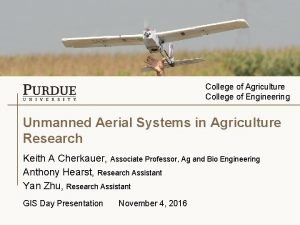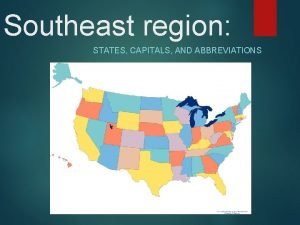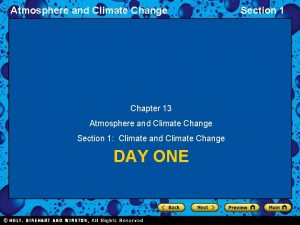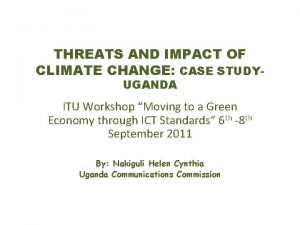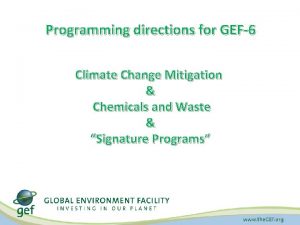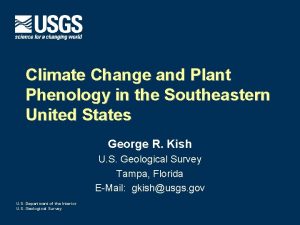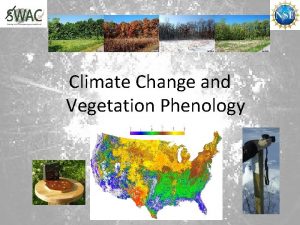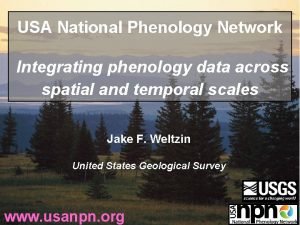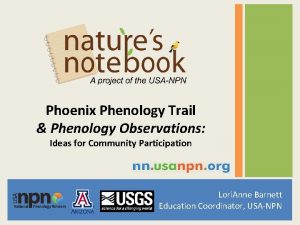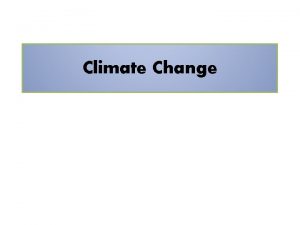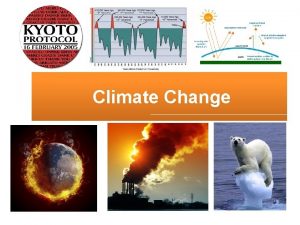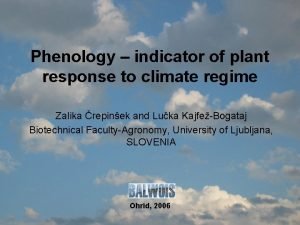Climate Change and Plant Phenology in the Southeastern


























- Slides: 26

Climate Change and Plant Phenology in the Southeastern United States George R. Kish U. S. Geological Survey Tampa, Florida E-Mail: gkish@usgs. gov U. S. Department of the Interior U. S. Geological Survey

Evidence § Key Findings § Temperature § Sea level § Snow cover © IPCC, 2007

Key Findings – Intergovernmental Panel on Climate Change (IPCC) § § Ecosystems on all continents affected Globally ~20% to 30% of species will be at increasingly high risk of extinction by 2100 Conservation practices poorly prepared for adaptation Effective adaptation will be costly

Projected climate change effects for the Southeast by 2090 § § § Accelerated wildfire frequency – a warmer, longer dry season Increased human health risks from exposure to heat Increased pest epidemics (pine bark beetles) Sea-level rise in coastal areas Reduced availability of soil moisture to plants Changes in ecosystem community dynamics § § Soil drying leading to forest losses and savanna and grassland increases Both drought and fire play an important role in the forest breakup

Summer Heat Index = f (temperature, humidity)

Precipitation Change Soil Moisture Change

Phenology § Phenology - Study of the timing of recurring biological phases, the causes of their timing with regard to biotic and abiotic forces, and the interrelation among phases of same or different species § Phenophase – Bud break, unfolding of first leaf, flowering, fruiting, turning of leaves, animal migration, emergence, growth stages, breeding, nesting, hibernation, etc.

Syringa vulgaris (common lilac) Syringa chinensis (cloned lilac) Schwartz and Reiter 2000 International. J. Climatology First Leaf = widest part of green leaf past brown winter bud tips)

Spring index - first leaf date for lilacs Trend toward earlier first leaf date Schwartz and Reiter, 2000 International. J. Climatology

Hu, Q. , Weiss, A. , Feng, S. , & Baenziger, P. S. (2006) Early winter wheat heading dates and warmer springs in the U. S. Great Plains. Agricultural and Forest Meteorology 135: 284. Heading date: when head (spike) on 50% of the Kharkof cultivar emerges from the flag leaf.

Smithonian Natural History Museum § § § 100 plants in D. C. area 89 showed earlier blooming Deadnettle § Bloom 39 days earlier than in 1970

Issues for Southeastern Phenology 1. 2. 3. 4. Will heat tolerance of sensitive species cause shifts in range? Will water stress along hydrologic gradients cause long-term shifts in plant community structure? Are plants blooming or setting fruit earlier because of climate change? Will these shifts alter species diversity and the function of ecosystems?

Species Range Shift § § § Many species reach their southernmost range in the Florida peninsula Provides opportunity to monitor range shifts Challenge – to isolate global climate change from ecological and local weather processes

Liriodendron tulipifera (tulip tree) § Large (>100 ft tall) deciduous tree typical of the mid-Atlantic region § Southern limit – mid-peninsular Florida § Monitoring phenology of key species will provide evidence of range shifts

Hydrologic Gradient Shift § § Soil drying may cause species or community changes Opportunities for exotic invasive plants Long-term drying may permanently alter community structure A serious issue for protecting wetlands

USF Eco. Area

Mesic Hydric Xeric

Sandhill (xyric) Hydrologic Gradient Transition (mesic) (Source: G. Kish, unpublished data from USF Eco. Area) Cypress Swamp (hydric)

Longleaf pine Scrub live oak Turkey oak Saw palmetto Xeric Site

Laurel oak Ferns Mesic Site

Pop ash High water line Bald cypress Hydric Site

Species Distribution § Xeric site Dry § Longleaf pine, turkey oak, scrub live oak § Mesic site § Laurel oak, slash pine § Hydric site § Bald cypress, pop ash Wet

Species Abundance

Monitoring Strategies for Change § § Life cycle – timing, vulnerability to heat and water stress Range – northward retreat or elimination of heat-sensitive species; colonization by opportunistic species Hydrologic gradient - replacement of hydric species along hydrologic gradients in response to drought and hydroperiod changes Community structure

Tier 1 Tier 2 Tier 3 Tier 4 Intensive Sites Ameri. Flux NWS Coop Spatially Extensive NPS Inv. & Mon. Science Networks State Ag. Exp. Sta. Nature Spatially Extensive Preserves, Volunteer & Education Networks Campuses Remote Sensing and Synoptic (wall-to-wall) Data NASA USGS NOAA Increasing Process Knowledge Data Quality # of Measurements Decreasing Spatial Coverage USA-NPN Monitoring Framework

Southeastern Phenology Network Plans § § Uncover Legacy Data § § Citizen scientists Biological Research Stations and Nature Preserves Botanical Gardens and Herbariums Theses and dissertations Southeastern Phenology Workshops § § § Implement monitoring protocols for Southeast Select Tier 1, 2, and 3 sites for Region Develop remote sensing approach Design web site Develop priority research agenda
 Climate change 2014 mitigation of climate change
Climate change 2014 mitigation of climate change Phenology
Phenology Phenology definition
Phenology definition Usa national phenology network
Usa national phenology network Southeast region states and capitals
Southeast region states and capitals Southeastern and gulf cultures
Southeastern and gulf cultures Southeastern universities research association
Southeastern universities research association Southeastern states pupil transportation conference
Southeastern states pupil transportation conference Southeastern leonet
Southeastern leonet Sector se new england
Sector se new england Climate change meaning
Climate change meaning Atmosphere
Atmosphere Chapter 13 atmosphere and climate change
Chapter 13 atmosphere and climate change Tronsmo plant pathology and plant diseases download
Tronsmo plant pathology and plant diseases download Tronsmo plant pathology and plant diseases download
Tronsmo plant pathology and plant diseases download Albugo eye
Albugo eye Climate change paragraph
Climate change paragraph Karnataka state action plan on climate change
Karnataka state action plan on climate change How many major climate types are there worldwide brainpop
How many major climate types are there worldwide brainpop Unit 9 climate change
Unit 9 climate change Conclusion of climate change
Conclusion of climate change Conclusion of climate change
Conclusion of climate change Conclusion of climate change
Conclusion of climate change Mathematics of climate change
Mathematics of climate change Globalization ap world history definition
Globalization ap world history definition Climate change mitigation
Climate change mitigation 414 climate change
414 climate change

